#kalda woulda shoulda
Text
Kald’ve, Would’ve, Should’ve (and Finally Did) Commentary

No no, of course I didn’t forget, you forgot. And I couldn’t blame you if you did, it’s been some time coming. Commentary may be a special action, but it obviously still uses the stack - and as it gets stacked under more and more things, it can take a while to see it resolved. While I can’t promise the next one is going to have split second timing, I’m definitely going to be adjusting my schedule to make getting things out on time more manageable.
This challenge revisited what I started with the release of Zendikar Rising, albeit with a slightly looser approach, and I definitely enjoyed the increased diversity that I saw in submissions because of it. I think it’ll take a couple more of these before I'm able to mould my prompt to hit exactly the kind of results I’m looking for, so I doubly appreciate everyone participating in my little mad science design experiments in the meantime.
That said, let’s not keep you waiting...
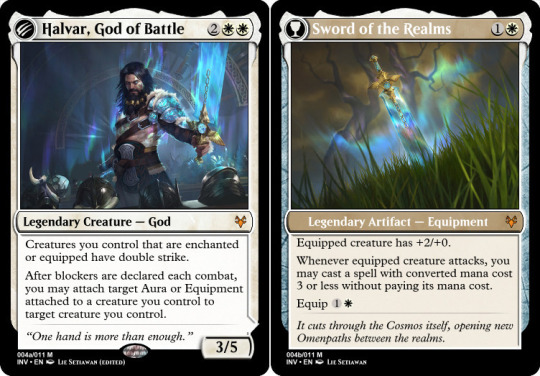
@bread-into-toast - Halvar, God of Battle // Sword of the Realms
Flavour: This was a direct cleanup of a card that was already in the set, so there wasn’t a lot of flavour to credit you with specifically. There is new flavour text on the front face (which wasn’t an option on the printed version thanks to the MDFC frame treatment) that I suppose gives us slightly more insight into Halvar’s personality.
Mechanics: The front face has one minor change to the timing of the combat ability that does succeed in making it objectively more powerful, but probably does not make for more interesting gameplay overall - it pushes more of the combat math onto your opponents, essentially reducing the decisions you make to “what punishes these blocks the most.” The back face has a more significant change, trading out the original’s recursion ability for an ability that I assume is supposed to better represent the Omenpaths flavourfully, since it’s certainly not a core white effect. In practice I have to imagine the recursion ability plays more nicely with the equipment theme than a ramp effect does.
Nitpicks/Templating: The front face trigger would read “At the beginning of the declare blockers step each combat,” which is admittedly confusing because “beginning” implies that it’s before blockers even though it wouldn’t be - the awkwardness of the template is probably a reason we don’t see it more often. The ability on the rear face would want to specify where you’re casting the spell from like Sram’s Expertise does, otherwise you’re leaving it up to players to guess which spells it’s allowing them to play, and they’ll often guess wrong.
Overall: Shop the art all you want, I still think he’s as handsome as ever.
--
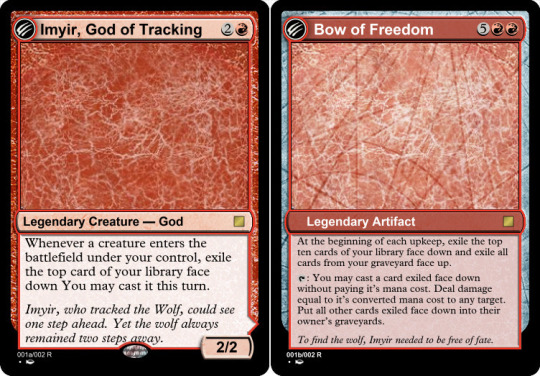
Charmera - Imyir, God of Tracking // Bow of Freedom
Flavour: I feel like I might be a little sketchy on the flavour for this one, but I believe the idea is that Imyir was fated to track “the Wolf” but never catch it, and had to break free of that fate in order to finally succeed. That definitely sounds like a neat concept, and I think you could’ve been even a little more explicit in delivering on it to really drive that story home - though I suppose this does already have more space devoted to flavour text than any of the Gods that did see print.
Mechanics: The ability on the front face is very powerful, I suspect the fact that the draws are temporary is a relatively small downside compared to the ability to chain card draw by hitting creatures one after another. The back face is... Well, I’ll be honest that I don’t know what you intended it to do. Indeed, both sides are exiling cards from your library face down, meaning you have no idea what they are, but allowing you to cast them. Is it supposed to be casting one at random? Did you forget to include the part where you look at the cards? That confusion aside, the 7-mana legendary artifact that mills you for 10 every turn (but explicitly hoses any graveyard synergies) doesn’t sound particularly exciting, though I guess if the effect isn’t intended to be random the free cast would be quite powerful. But just imagine casting this in multiplayer and milling yourself for 50 cards just to get to cast one for free - the ratio doesn’t seem appealing.
Nitpicks/Templating: If you want players to know what’s under their face down exiled cards, you’ve got to include a “look at” line. If a player was able to look at it once they’ll be able to look at it as often as they like for as long as it remains exiled, but that first look has to happen explicitly. Also: 8 lines of text does not have room for flavour text.
Overall: I just hope the Wolf made it out okay.
--

@col-seaker-of-the-memiest-legion - Scythed Whirlwind
Flavour: Embittered with time is definitely right up Egon’s alley, though the card name and the other aspects of the flavour don’t feel like they resonate particularly strongly with me. If there’s a way the flavour is supposed to lend itself to the mechanics, I’m not immediately seeing it.
Mechanics: You mentioned in your submission that you intended this to be a “skill-testing” board wipe, but I’m struggling to imagine what skill this would be testing. This is obviously just a board wipe in the vast majority of board states, though obviously it does - somewhat - encourage you to play creatures with equipments, but in practice this is still just going into (near-)creatureless decks.
Nitpicks/Templating: Targets are chosen as part of casting a spell, so they can’t be conditional like this. You’d want the spell to be modal, as you won’t be obligated to select targets for the mode you didn’t choose.
Overall: Maybe it’s just me, but the name conjures images of kamaitachi more than anything out of Norse mythology. But I’m also not an expert.
--
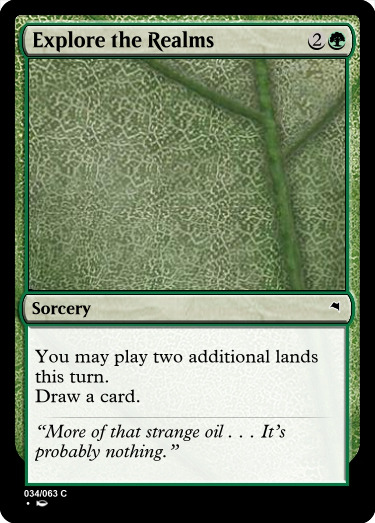
@corporalotherbear - Explore the Realms
Flavour: You acknowledged that flavour was your focus with this one, with the flavour text here hinting at an upcoming Phyrexian corruption of the ten realms. That makes some sense in the context of Vorinclex’s unexplained appearance, and indeed may wind up being something Kaldheim has to deal with in the future.
Mechanics: An Explore variant that lets you drop two lands instead of one, albeit for one extra mana. Ramping by two is a lot more powerful than ramping by one, but the requirement of having two lands available makes this a little less consistent. Generally speaking, cards with high power level and high variance tend to lead to unsatisfying play patterns, so I’d be nervous about the games where this does succeed in ramping from 3 to 6, even if it does so unreliably.
Nitpicks/Templating: Most quotations in flavour text are credited to someone, and while it’s not strictly necessary in a case like this, I think it would go a ways to helping deliver on the flavour.
Overall: Ten realms is an upgrade over nine hells, I guess.
---

@deg99 - Nith, Root Gnawer
Flavour: Your goal was to deliver on more dragons, and this kinda does that. I’ll admit that I’m lost on why it’s also a Troll, as those are completely separate species and it doesn’t appear to be an obvious crossbreed of the two. It’s not immediately obvious what the lands in graveyard clause is supposed to represent flavourfully, but if Gadrak is any indication that isn’t really necessary.
Mechanics: What stands out most here is - obviously - the repeatable land destruction. Against anything but the rampiest of decks, if you have this on the battlefield by turn six it is very unlikely for any opponent to recover from blowing up a land and creating a large token every turn. The fact that it’s unable to attack early really doesn’t feel relevant, because it’ll rarely be attacking late either - the upside of denying your opponent resources while expanding your board is almost always just much better than 5 damage.
Nitpicks/Templating: Templating favours common contractions, so it’s “can’t attack,” and (for whatever reason) only subtypes are ever capitalised: “4/4 green Troll Warrior creature token with trample.”
Overall: Repeatable land destruction is certainly a trollish thing to do, I’ll give you that.
--

@demimonde-semigoddess - Huatli, Guiding Hand
Flavour: Huatli on Kaldheim is a curious inclusion, feeling even more out-of-place than the existing non-native planeswalkers - of course this isn’t exactly a bad thing, as planeswalkers aren’t really supposed to blend in anyway.
Mechanics: The interplay between the three abilities here seems reasonable enough, the downtick creating tokens that trigger the first ability, and the uptick allowing them to trigger it on both attacks and blocks. It’s a little unexpected that both ways of triggering the ability are inherently aggressive (the block trigger only succeeds in tapping down blockers for the next turn), and cute that the otherwise unique tribal effect works with changelings in the set. It’s a little hard to gauge the overall power of three-mana planeswalkers as there’s often a thin line between unimpressive and broken so I won’t pretend to know how powerful this is just by looking, though I imagine the difficulty of blocking against it would give creature decks lots of trouble.
Nitpicks/Templating: You likely know the creature type in the first ability should be capitalised, and abilities with multiple targets read “each get” for the sake of clarity.
Overall: Is it the dinos that her hand is guiding, or something else?
--
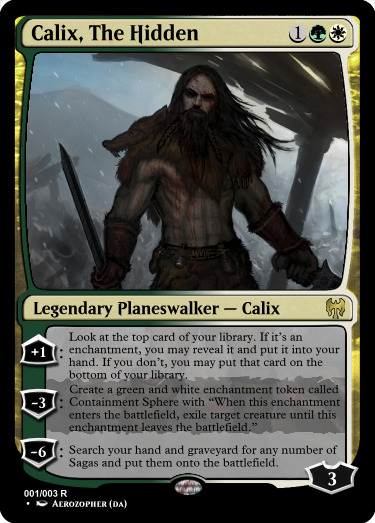
@dimestoretajic - Calix, the Hidden
Flavour: This is an unexpected take on Calix, taking on a rather different appearance presumably as a disguise. It’s not immediately clear to me what he’d be hiding from, but the reference to Kratos is cute even if it’s ultimately confusing.
Mechanics: Always hard to evaluate planeswalkers without the benefit of iteration, but the abilities seem roughly in Calix’s wheelhouse. The first ability is a scry that upgrades to a draw if it hits an enchantment, probably reasonable enough at three mana; the downtick lets you trade him in immediately for a Stasis Snare effect; and the ultimate gives you a bunch of free Sagas. I think the idea of Calix interacting with Sagas is a little cute, though he definitely had that opportunity on Theros and didn’t so it might have been best to do it a little more subtly.
Nitpicks/Templating: The first ability feels like it has a lot of decision points for digital; I’d consider just revealing in the first place to save some clicks. The second ability is probably much wordier than it should be; I don’t think you gain much by naming the token (or by making it green), and the exile effect should probably just look closer to original Calix’s downtick. Be careful with so many wordy abilities on one planeswalker; I understand the desire to be clever, but ironically being elegant is even cleverer than being clever.
Overall: I’m down for Calix with a beard.
--

@driftingthruthecosmos - Immortal Triumph
Flavour: This appears to be playing into the trope space of Valhalla, letting your permanents ascend to the beyond only to return for a prophetic final battle. I think the art is an actual depiction of Valhalla, and the name generally signals toward the same concepts without actually embracing Kaldheim’s application of the same trope space, “the Worthy.”
Mechanics: This card definitely doesn’t work as written, but I prefer to judge design on the design’s merit’s, so I’ll do my best to work out how you expected it to work. The fact that this hits any nonland permanent makes it quite versatile, allowing it to return the same permanent turn after turn which can be difficult to overcome - even something as innocuous as Omen of the Sun can be pretty overbearing being recurred turn after turn with relatively little room for counterplay.
Nitpicks/Templating: The first ability leaves a few unintuitive holes where permanents can be lost despite the replacement effect. The second one appears to grant foretell (and a foretell cost) to a card it just put in your hand, which isn’t logistically feasible since your hand is a hidden zone. I’m not sure why the ability didn’t just turn the chosen card face down and make it foretold a la Ethereal Valkyrie.
Overall: I think my biggest wish for this one would be that the ‘glory’ was actually something you had to earn, rather than being totally universal.
--
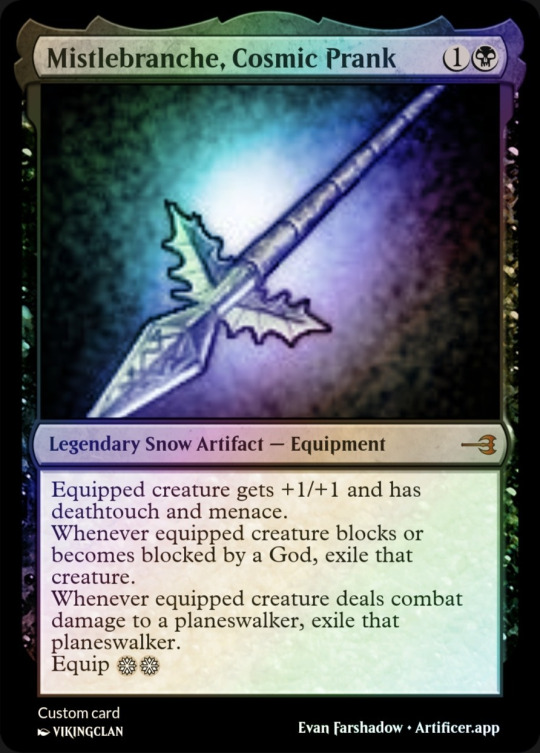
@evscfa1 - Mistlebranche, Cosmic Prank
Flavour: The core idea of a weapon based on mistletoe deriving from the story of Baldr is really sweet, though some of the aspects of this design seem to stray a bit from that core concept. Most significantly the decision to make it a snow permanent with a snow equip cost seems rather unexpected.
Mechanics: Not to sound like a broken record, but the snow equip cost is what catches my eye the most: it makes the design very narrow, being completely useless without two snow sources plus a creature to put it on. Once it’s equipped, deathtouch and menace means that any creature this goes on will immediately be trading 2-for-1, making it really difficult to keep up with in any deck that’s able to produce tokens. Exiling planeswalkers too is a cute addition, and particularly powerful alongside making your creatures highly unprofitable to block.
Nitpicks/Templating: If you’re gonna make a weapon based explicitly on a plant, how did it end up anything but green? I imagine you designed the abilities first and chose the color to fit, but in this case I think the color was probably an important aspect of delivering on the concept and wasn’t a good place for compromise.
Overall: The name Mistlebranche sounds so elegant, though.
--
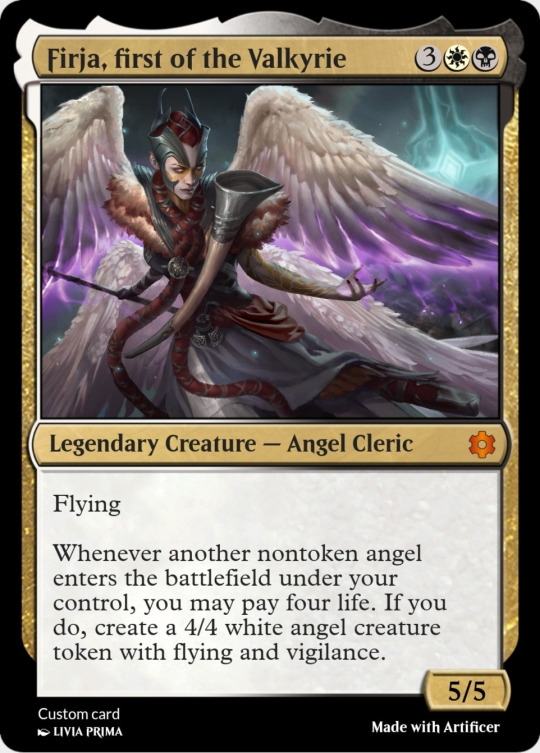
@fractured-infinity - Firja, First of the Valkyrie
Flavour: Reusing the Firja character with a new title. There’s enough about Firja elsewhere in the set to inform her character a bit, but that also means the title change can only do so much to change my perception of her.
Mechanics: The four life as a cost is pretty close to free here, but it does at least force you to adjust your play patterns to preserve your life total as you work up to it. In practice this is the kind of card you generally hold onto until you can guarantee some value from, and since we don’t see many Angels below three mana, this would often be waiting until eight to get played. That’s probably reasonable though, as once it does get going it tends to end games very, very quickly. This has the interesting upside of being less bad in multiples than most legendary creatures, as the second copy of this can still be cast to generate a token off the first.
Nitpicks/Templating: “First” in the name and each instance of “Angel” in the text ought to be capitalised, and life is always expressed with numerals: “4 life.”
Overall: Nice to see her growing out of that awkward Judge of Valor phase.
--

@hypexion - Kaya’s Gambit
Flavour: A play on the existing Divine Gambit design, with a couple minor tweaks. Interestingly, the flavour text comes very close to standing on its own - I didn’t remember the original’s, and yet it made some sense on its own (though perhaps it would’ve made less if I wasn’t aware of Divine Gambit already). The biggest miss is that the “gambit” part of the name makes virtually no sense with this design, as there’s no risk involved in using it.
Mechanics: Flexible if conditional removal. At worst it’s Disperse, at its best it’s just an exile effect. The biggest differences between this and the original are the open information and the (virtual) lack of a failure rate: with open information you’ll never be surprised by what your opponent gets back from this, and only returning the card to hand means that it’s rarely just not worth doing at all. This is clearly a more powerful version of the effect, but I’m not convinced it’s either more interesting nor a more appropriate power level.
Nitpicks/Templating: You probably want to use “with that permanent” instead of “with it”, as the text refers to multiple objects and they like to be as unambiguous as possible. I looked for examples that used “it,” but I didn’t immediately find any.
Overall: There are white cards, and then there are good cards.
--

@i-am-the-one-who-wololoes - Winter Travels
Flavour: The name definitely conveys both the concept and the mechanics reasonably well, and the flavour text itself is really evocative and has great imagery to it.
Mechanics: A mistake designers tend to make when designing for a known format is throwing multiple elements of that format onto the same card: when not done carefully, the result is a card that only works in a narrow intersection rather than being interesting in each archetype it makes use of. In this case, Snow archetypes make much better use of this than foretell archetypes, meaning this probably should’ve just accepted it was a Snow card and dropped foretell altogether.
Nitpicks/Templating: The template is unclear about whether the second condition - all snow mana - applies only when the spell is foretold or not, which is always going to be a problem with double-conditional cards. Also: this card had 9 lines of text before you put flavour text, it’s important to know when to make cuts.
Overall: Maybe I’ve read too much Robert Frost, but I really appreciate how poetic the concept here feels.
--

@ignorantturtlegaming - Elendriel, Twisted Prophet
Flavour: It’s not super clear to me who or what this is supposed to represent. The name and typing is enough to hint at a broad identity, but there’s a lot going on and not enough string to really tie it all together.
Mechanics: Like I mentioned for the submission above, throwing lots of a sets themes/mechanics onto a single card generally makes that card narrower and less exciting, rather than more exciting. In this case you’ve got a card relying heavily on foretell outside of the foretell archetype colors, unable to meaningfully contribute to its own colors’ archetype (Elves) without foretell, plus a boast ability that feels out of place both mechanically and conceptually...and also depends entirely on foretell.
Nitpicks/Templating: Flavour text was pretty important for the boast cards. While there were a couple rares that didn’t have room for it, notably the legendary ones both did because the flavour text was instrumental in selling the mechanic.
Overall: Elves > Foretell > Boast > ??? > Prophet!
--

@kavinika - Tjalfi, the Godly Messenger // Fjara, Doomskar Lookout
Flavour: Your submission took some time to explain the top-down basis for these two - a servant of Thor (Tjalfi) and one of the roosters of Ragnarok (Gullinkambi) - though obviously you’ve taken some slight liberties. The biggest issue with the flavour here is that it diverges from what the set establishes the Gods to look like - double-faced creatures with elements closely related to their divine duties on the reverse. With the set having only limited space to create and deliver on expectations, there probably just isn’t space to also subvert those expectations.
Mechanics: Mechanically, it’s awkward to have a red card that generates longterm card advantage, even if the condition for doing so is essentially a red thing. The two sides sort of push you in the same direction - lots of nontoken creatures - and the trigger on Fjara theoretically helps to reclaim Boast creatures that were lost trying to trigger the opposite side. The mana costs seem hard to pull off in the same deck, but I can at least see the play pattern it’s trying to encourage - though I can’t help but wish Fjara’s ability was a Boast ability, just to really help the card enable itself as most of the Gods do.
Nitpicks/Templating: Tjalfi’s triggered ability runs on a bit, it probably wants to be separated into two sentences: “ [...] of your library. You may reveal [...]” I’ll also a nitpick that if you’re going to base a character on something as unique as a rooster that crows at the end of the world, you probably want to make the connection as clear as possible - I don’t think anyone is going to make that connection here.
Overall: Maybe I’m just salty that I didn’t get the chicken version.
--

@kytheon4-4 - Gunnar the Breathless
Flavour: You made sure to include flavour text, which I think was really important to selling the Boast ability as it appeared on cards in the set. The specific flavour text you chose comes off as wordy, the story it tells is hard for me to parse (one can only imagine where they’d tucked the troll’s club away whilst hitching a ride), and doesn’t feel like it connects in any obvious way to the ability on the card. One of the fun aspects of Boast was how well they focused on creating stories to explain the specific ability on the card, but apart from maybe interpreting the troll’s lunch as life gain, I’m just not seeing that on this one.
Mechanics: You’re right that it would’ve been nice to have one of the Boast enablers show up at a lower rarity, though I’m suspecting that it probably didn’t for power level reasons - Boast is actually pretty powerful, and I wouldn’t be surprised if one of the rare enablers had started out at uncommon and gotten pushed to rare for being too impactful. I think it’s nice of you to try to make the ability broad enough to work outside of just Boast - there are a few things this breaks in older formats, but in Standard the scariest thing it can do is enable Kargan Intimidator or Subira, both of which are probably safe enough even with free abilities.
Nitpicks/Templating: All the templating stuff looks fine.
Overall: The irony of “the Breathless” holding a horn is not lost on me.
--

@masternexeon - Aggravated Berserker
Flavour: This card is a little light on flavour, which I’m normally just fine with, but in the context of Boast the flavour does a lot to bring the mechanic to life. It’s clever that the name is a throwback to Aggravated Assault, but I think a little more attention to detail could’ve helped it really pop.
Mechanics: Obviously this was really close to one of the winners, with the big difference being the Dwarf tribal element. Obviously I favoured the version that had a slightly broader appeal, but since Dwarf tribal was one of the themes of the set, there’s probably a version of this design that does both (extra combat for everyone plus a bonus for Dwarves) that I would’ve liked better than either.
Nitpicks/Templating: You’ll want to make sure to capitalise “Dwarves” in your rules text.
Overall: No spoilers, but this one almost seems designed with my next challenge in mind.
--

@misterstingyjack - Toralf and Valki Deceive the Giant King
Flavour: Boy howdy, that’s a name - I’m impressed that your renderer got it to fit. This is a top-down story about Thor disguising himself as his own mother in order to trick a giant that wishes to marry her into returning his hammer. The chapters of the Saga follow that pattern pretty precisely, letting you disguise one of your creatures and - over a couple turns - steal an artifact from an opponent. You might have considered swapping chapters 1 and 2, so that the destruction effect could represent the hammer going missing which prompted the whole endeavour. Indeed, then you could even move the mill effect into that ability, to represent the hammer being buried after it’s stolen.
Mechanics: Similarly, I think putting the destruction effect up front would’ve done this card some good. The copy effect is cute, but it’s not the most powerful effect on the card, and as written this is pretty easy to blank with a removal spell. I do really like the way the abilities intersect the colors - destroying an artifact or creature requires both colors, temporary copy effects from a graveyard feels both red and black, and recurring an artifact is something red can do that still feels pretty black.
Nitpicks/Templating: As much as I respect how ambitious the name was, I’m confident you had shorter options available.
Overall: It’s always lovely to see a top-down story that you enjoy getting represented as a card, nice choice.
--

@mtg-ds - Koll, Breath of the Bellows
Flavour: I definitely understand your frustration that there aren’t more smiths that do actual smithing in Magic, instead just encouraging you to build a deck that simulates their doing so. This correction for that is pretty straightforward, making axes and shields to equip to your army.
Mechanics: The low costs on this are going to lead to a lot of Equipment tokens on the battlefield at any given time - any time you have unspent mana you’re going to pour it into making tokens, especially since you can do so at instant speed. Combining that with the first ability reducing the Equip cost to zero, you’re going to have a mass of equipments shifting constantly from creature to creature, which just seems logistically difficult to keep track of.
Nitpicks/Templating: Everything looks right to me.
Overall: I have to assume stumpy Dwarven limbs are to blame for why they’re wearing shields on their shoulders rather than strapping them to their arms like the rest of us.
--
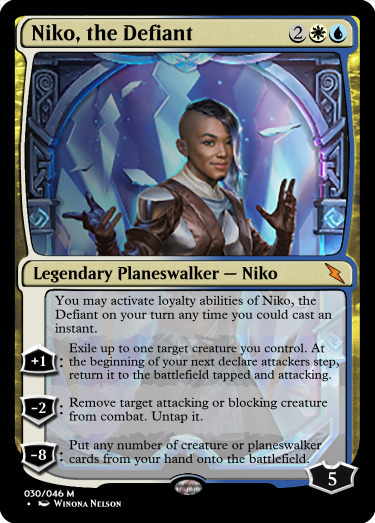
@naban-dean-of-irritation - Niko, the Defiant
Flavour: Niko was immediately a beloved character for a lot of us, so I can definitely understand wanting to reimagine that character more in line with your perception of them. It’s hard replacing the first iteration of a planeswalker because all the lore we have available is the card that exists and stories based on that card - so it’s just inherently difficult for me to see how these abilities relate to the character, since it’s essentially establishing a different character with the same name.
Mechanics: The most glaring issue is the fact that the first ability essentially gives haste on a WU card, which qualifies as either a very strange design choice or a pretty significant oversight. The third ability also feels like it’s skirting the color pie, presumably attempting an Omniscience impression that just feels out of place for this pair. The uptick and downtick feel like they’re designed to do pretty similar things, both primarily saving creatures from unfortunate blocks. I suspect the reason is that the ‘instant speed on your turn’ effect pushed the design into rather narrow space, where two abilities came out very similar while the third simply doesn’t really benefit from the instant speed.
Nitpicks/Templating: No obvious templating woes.
Overall: As much as I respect their defiance, defying the color pie is where I draw the line.
--

@nine-effing-hells - Fraenir, the Greed-Cursed
Flavour: I always enjoy top-down designs especially, and this story of a Dwarf hoarding treasures until they transform into a Dragon is such an excellent place to mine for those designs - and really, what set wouldn’t want more Dragons? The abilities themselves tell a story of murser and greed, even without needing flavour text to help it along.
Mechanics: I think my biggest issue with this design is that rather than the transformation being something you work towards or work to avoid, it is awkwardly positioned between the two - there are times the Dwarf Berserker will be larger by virtue of controlling lots of non-Treasure artifacts, making it unclear what the play pattern of the card actually is. It does have the benefit of being easy to avoid transforming when you don’t want to, but I think it would suit the design better to arrange the abilities to make the comparisons between the two states clearer (for example, giving the Dwarf non-combat abilities and saving the combat abilities for the Dragon half).
Nitpicks/Templating: Easy mistake, you missed the word “token” in the sacrifice trigger.
Overall: I’m really curious what the art for a card like this would look like.
--
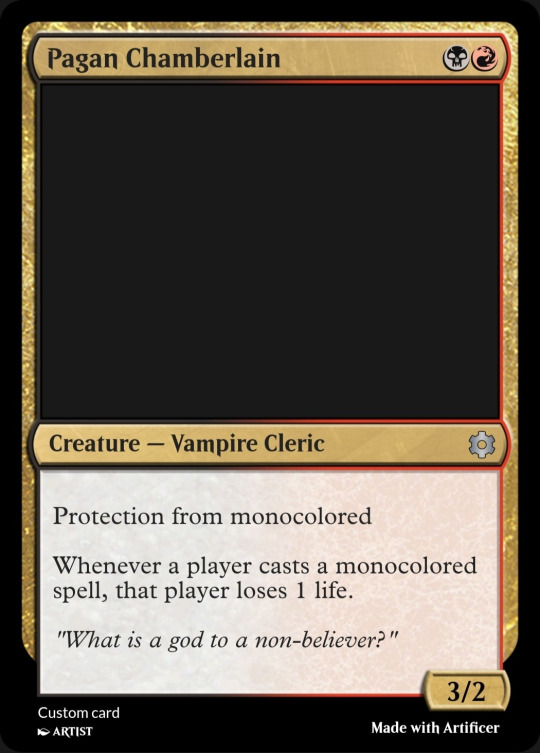
@partlycloudy-partlyfuckoff - Pagan Chamberlain
Flavour: I have to assume the whole design was for a chance to use that flavour text, as the other aspects of the card don’t seem to align with Kaldheim as a setting - the world has no actual vampires, and the concept of a non-believer makes a lot less sense in a world where gods are as tangible as this one.
Mechanics: Similarly, this isn’t playing into any of the mechanical themes of the set; there isn’t even a strong monocolor theme to run counter to. I suspect the rationale is that each of the gods in the set are monocolor creatures, but seeing as there’s already a card in the set with protection from Gods, it seems strange to try to be subtler about it than that one.
Nitpicks/Templating: Nothing much to nitpick over.
Overall: In this set, the answer to that question is usually “an artifact.”
--

@real-aspen-hours - Ill Omen
Flavour: The name aligns well with the foretell mechanic, and the flavour text helps connect an important story beat to a broader narrative and to the flavour of the card itself. I’d be a little reticent about including such a significant spoiler in flavour text, but perhaps there’s a way to phrase it so that it reads like a prophecy until you find out it’s already happened.
Mechanics: This is effectively three-for-one removal, which is a lot of value for a single uncommon. Locking it to sorcery speed gives at least some incentive not to foretell it, as that delays it for a full turn - it won’t be often you cast it straight, but that I can at least imagine the situations is a plus. It’s especially powerful in that when it isn’t useful as a removal spell, it allows you redraws for something more useful.
Nitpicks/Templating: Foretell shows up after the spell effect, even for those cards that care whether they were foretold. While we’re here, good catch on including a target in the card draw effect - while it would be easy to exclude one, ensuring that the spell has two targets keeps the whole thing from fizzling if the targeted creature disappears before it resolves.
Overall: This feels like it’s only a slight push away from being constructed playable, and I’d be interested to explore what more it takes to get it there.
--

@snugz - Surtland Rimereader
Flavour: I rather like the flavour here, a Giant that’s able to see the future with the help of the snow allowing you a Future Sight effect specifically for snow cards is pretty satisfying. It’s not immediately obvious what the last ability represents, but the rest of the card feels like it sells it well enough anyway.
Mechanics: I’m not entirely sure that blue is still able to play lands off of this type of effect; the original obviously did, but none of the blue variations since then have, and I’m not sure ‘snow’ is a blue identity to bend for it. The triggered ability feels a little bit awkward with the overall design since you specifically don’t have much control over the first spell you cast when you’re doing so from the top of your deck.
Nitpicks/Templating: Good catch on the updated template for Future Sight, as I don’t think they’ve actually printed any cards with that wording yet. It was updated some time after Bolas’s Citadel was printed, and we’ve yet to have another card in that style see print.
Overall: Would’ve loved a rime-rhyme pun somewhere in the set, and this feels like an opportune place for it.
--

@stormtide-leviathan - Kvasha, God of Magic // Kvasha’s Birth
Flavour: In this setting, the connection between enchantments and Spirits and flash doesn’t feel immediately obvious. Now naturally this is trying to create a connection where one didn’t exist previously, but it does feel like it muddles the flavour slightly to do so.
Mechanics: This is large and evasive enough to serve as a finisher even without making extra tokens, though the tokens can serve as some resiliency against removal. I’m not entirely sure how the flash ability relates to the rest of the card, except to change the template of the Saga’s first ability. If that were so important I’d have looked for a first chapter ability that could take advantage of being cast at instant speed, but then more likely I would’ve just cut the flash bit entirely.
Nitpicks/Templating: I’m not sure what it was intending, but there’s no way for a chapter ability to see the object it’s on entering the battlefield - that ability won’t resolve until well after the permanent has entered, and if it somehow re-entered the battlefield it would do so as an entirely new object. The last chapter ability will want to specify whose controller the object returns under (usually its owner’s), and you’ll want to move the ‘face-up’ bit into reminder text - you don’t need rules text to make it work that way, but it’s definitely worth clarifying for players who might not realise.
Overall: My favourite god designs in this set were the ones that let you use both sides with just one copy.
--

@thedirtside - Ragnarock
Flavour: The setting for Kaldheim reworked the concept of Ragnarok into what they called a Doomskar, leaving the original name feeling out of place within the setting. The color combinations used for the spell also aren’t represented in the setting, making it difficult to imagine what part of the world this is supposed to be representing in practice.
Mechanics: The most obvious point here is that the foretell cost and the casting cost don’t overlap, making it almost impossible that any given deck will actually have the option of casting it both ways - since the options it provides are the only thing that makes foretell interesting, intentionally designing to hamper that doesn’t seem like a good use of the mechanic. The foretell cost is also much easier to pay than the casting cost, making the added bonus for foretelling the spell feel really counterintuitive.
Nitpicks/Templating: It’ll take a slightly wordier template to achieve the second part of this effect, something like: “For each permanent destroyed this way, CARDNAME deals damage to that permanent’s controller equal to that permanent’s mana value.”
Overall: That must be a really big rock.
--
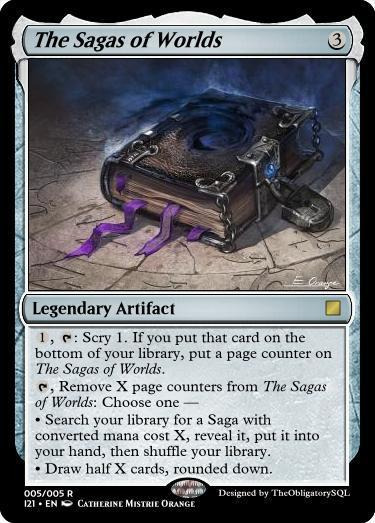
@theobligatorysql - The Sagas of Worlds
Flavour: One of the fascinating things about Sagas is the way they use art to represent the stories for them - this set uses carvings, reliefs, even tattoos as a form of storytelling. So while the idea of compiling them all into a single tome is cute, it feels to me like it isn’t exactly fitting for the world itself. I could definitely see it as the work of an outsider - Tamiyo, for example - but it feels like it makes less sense as something native to the plane.
Mechanics: I’m a sucker for designs in the vein of Treasure Map and Mazemind Tome, so an artifact with a cheap scry effect is right up my alley - though admittedly, I’m not sure why this inventivises scrying to the bottom as that complicates the calculus and will cause players to make bad scrying decisions for perceived value a nonzero amount of the time. I’m never a big fan of tutoring as it tends to lead to repetitive gameplay, and the fact that it takes at least 4 full turns to set this up to draw even a second card means that it’s nearly always going to be fetching up a cheap Saga instead of a random draw.
Nitpicks/Templating: I’d probably just use “scried” in the first ability, though admittedly that templated hasn’t been used yet.
Overall: This would be a great opportunity to finally get the word “edda” on a Magic card.
--
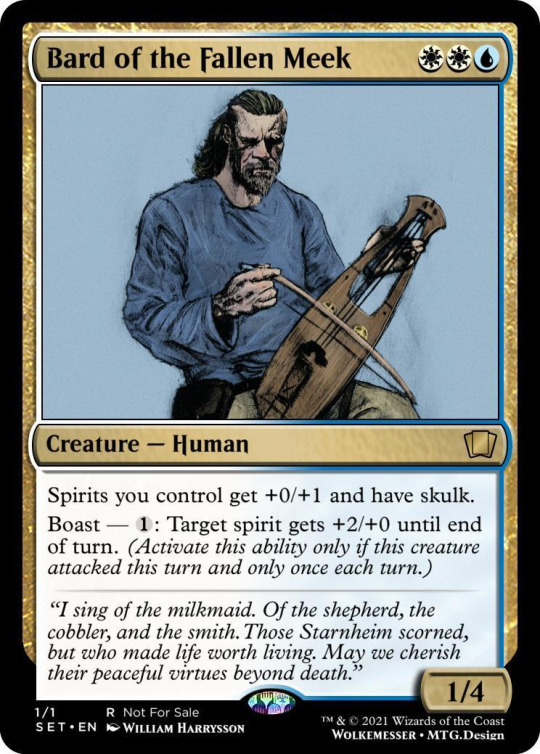
@wolkemesser - Bard of the Fallen Meek
Flavour: This was actually far and away my favourite submission to this challenge in terms of flavour, as I love the way it draws attention to the difference between Istfell and Starnheim, and shows regular individuals within the setting reacting to the concept of the Worthy. The flavour text itself could probably stand to be pared down to be a little punchier about the point it’s making, but I absolutely love what it’s trying to do.
Mechanics: That said, the implementation is a little messier. The skulk mechanic was used in one block five years ago, so certainly doesn’t qualify as evergreen. I like that the creature itself has stats that make it easy to safely get its Boast ability going, though the ability itself feels rather unexciting. I’m not sure what about the card demands the double white in the mana cost, or even what makes this a rare over an uncommon.
Nitpicks/Templating: You missed capitalising “Spirit” in the Boast ability.
Overall: I would’ve loved to pick this as a winner, next time try an extra pass or two to make sure you’re hitting all the aspects of the challenge.
14 notes
·
View notes
Text
Kald’ve, Would've, Should've
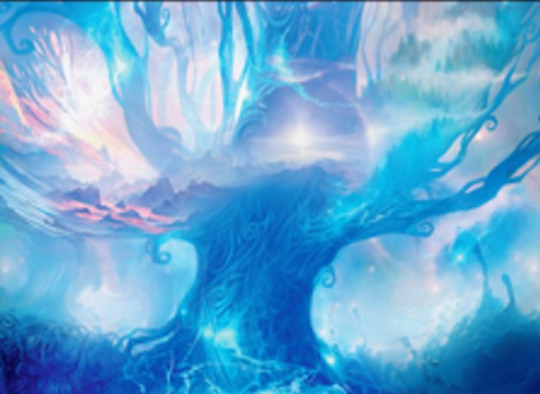
It’s that time again, and with the release of a new set I am once again asking for your missed design opportunities - this time, your lost heroes of Kaldheim! Like I said the first time around, I’m hoping to make this a recurring feature of the blog, and much like my favourite draft archetypes, that means just forcing it and hoping the cards turn up anyway. Of course in this case, the cards are up to all of you.
For this week’s challenge, I want you to come up with cards that coulda, woulda, shoulda been included in the new set. Something you can imagine was wrongfully left on the cutting room floor, a better version of a card that did see print, or something particularly clever that the rest of the design team just missed. This time around, consider real-world myths and tropes that you would’ve liked explored through Kaldheim mechanics as well.
The Goals (M.E.O.W.)
Mandatory: Design a card that could have appeared in Kaldheim. Use only mechanics from the set or those that are evergreen.
Encouraged: The most successful designs will be those that mesh the the mechanical themes of the set with its top-down influences.
Optional: You don’t need to use any of the named mechanics from the set, as long as your card feels like it belongs within the set and its setting.
Warning: Be aware of not only what mechanics exist, but how they exist. If the set gives a certain meaning to a mechanic, be careful not to undermine it.
As always, a full spoiler of the set is available here. Be sure to pay attention to the themes as you look through it, as those should really be guiding your design decisions this week. Innovation is strongly encouraged as always, but this week will test your ability to innovate within an existing set of themes.
NOTE: After a bit of feedback from our last such challenge, I’m going to be a little more lax with judging this time around. Rather than focusing on things like design skeletons and as-fan, we’re going to give you the space to just explore what you would’ve wanted to see in the set. You’re still limited to one card so you’ll have a hard time introducing whole new themes, but no need to worry about which specific slot in the design skeleton your design would be occupying.
Don’t forget that the inbox is open for questions and concerns, but beyond that just enjoy traversing the ten realms of Kaldheim!
~Mod [ @3smuth ]
Submit your lost heroes: > HERE <
And visit our Discord realm: > HERE <
12 notes
·
View notes
Text
Heroes of the Realms

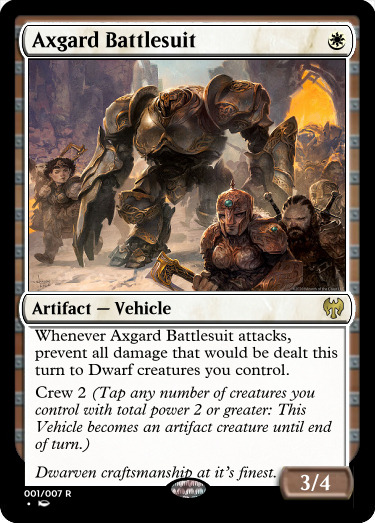
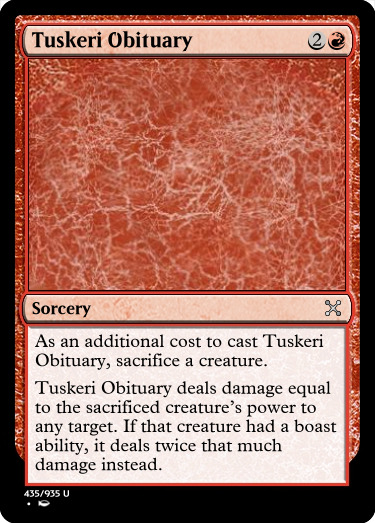
Apologies for the slight scheduling hiccup this week, but nonetheless congratulations to our winners: @dabudder, @dumbellsndragons, and @gollumni!
Immustrum Champion
While I don’t necessarily agree with your critical take on my good friend Arni, this does feel like a pretty natural space for Boast to play in that was surprisingly unrepresented. The body of the creature itself feels appropriate and the first strike helps ensure that it’s safe to attack in with, and the effect seems both exciting enough to justify being mythic, but not inherently so powerful as to be broken. Indeed, I suspect the only reason a design like this didn’t appear in the set was to avoid doubling up with Embercleave in Standard, which already provides a lot of reach to red agressive decks - giving them a second way to go over the top by turn five was probably just a little too much. All that aside, this design was an elegant application of the mechanics from the set, taking advantage of the natural restrictions of the mechanic itself.
Axgard Battlesuit
What I appreciate most about this one is the rather aggressive costing: while there were several elements of the set that encouraged Dwarf/Vehicle/Equipment synergy, none of the ones that saw print felt particularly powerful or compelling. This makes for a potentially playable base that might make some of those less powerful payoffs worthwhile, with a reasonable benefit for running it in a Dwarf-heavy deck while not being necessarily restricted to it. Attacking with 3 power on turn two can be quite the beating, but I suspect the 3/4 body is just enough to keep it from being especially relevant all the way through the late game - which is generally how you want to balance aggressive attackers. I like the way it requires you to risk the Battlesuit itself in order to protect your other Dwarves, always giving your opponents some degree of counterplay.
Tuskeri Obituary
This is a much subtler design, but I was impressed with how well it interacted with several of the archetypes in the set: it slots into the RW Boast archetype, the BR sacrifice archetype, and the UR spells archetype. While the spell itself isn’t particularly powerful, I think that’s something of a boon - being a late draft pick actually takes advantage of its flexibility by allowing it to serve as filler for any of those archetypes by virtue of not being picked too early. I think my biggest nitpick is actually the name: “obituary” conjures up the image of my grandmother grimly perusing the newspaper, while there are more poetic options like “elegy” or “eulogy” readily available. All told, I’m pleased that you were able to get this one in just under the wire, as I particularly appreciate flexible Limited designs in a challenge like this one.
--
Since I slipped up and got this out a day late, I’m going to go ahead and roll straight into the runners-up while we’re at it. Congratulations as well to: @hiygamer, @starch255, and @teaxch!
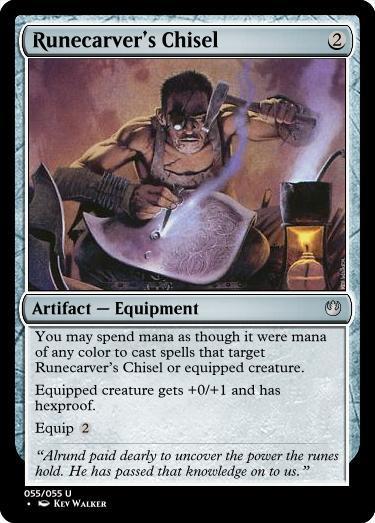
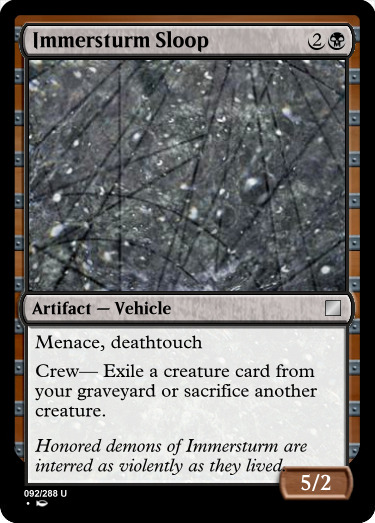
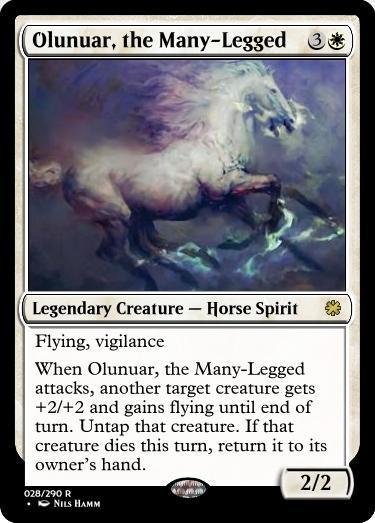
Runecarver’s Chisel
This is a cute addition to the RW Aura/Equipment theme in the set, and especially clever alongside Runes that are able to enchant either creatures or equipment. This serves as an equipment to place Runes on, but also grants hexproof to the equipped creature making enchantments on it more likely to stick around. The color-fixing element is comparable to the existing Rune payoffs in the set, but on this is intentionally broadened to include all targeted spells - Auras are the obvious ones, but expanding it to instants, sorceries, and even Mutate gives it the possibility of enabling some other interesting things within larger formats. I'm not totally convinced the color fixing is enough to make it constructed playable on its own and I probably would’ve liked a slightly more pronounced payoff, but I’d be interested to see whatever archetypes it manages to enable nonetheless, and I really appreciate its being aimed at broader formats while still capturing one of the important themes of the set itself.
Immersturm Sloop
I can definitely relate to your feeling that Funeral Longboat could’ve been delivered on more flavourfully, and I respect the direction in which you took it. Exiling creatures from your graveyard to crew a funeral boat makes a lot of sense to me, and while sacrificing creatures just to throw them a funeral service seems a little counterintuitive to me, I can see how that plays well with the mechanical themes in RB - I probably would’ve done just the former, since sacrifice themes tend to put creatures in the graveyard on their own. The biggest mechanical issue here is that this simply isn’t how Crew works: you could either do an alternate crew cost a la Heart of Kiran (which would still require a traditional Crew ability), or an activated ability similar to Peacewalker Colossus (which could be done instead of Crew). Deathtouch on something with 5 power feels a little excessive, but I suppose with menace it’s just there to ensure that any block is a two-for-one - or a two-for-two, assuming you sacrificed a creature of your own to crew it in the first place.
Olunuar, the Many-Legged
Sleipnir is a familiar element Norse mythology, and using Pegasus Courser as a model for expressing it as a card design was a pretty clever choice. In a practical sense it’s a little difficult to use this, since by virture of adding all its stats to the rider, it will always be easier to just block and kill Olunuar itself. This makes it slightly frustrating that the recursion effect doesn’t cover itself as well, and makes the recursion a little unlikely to ever see much use. The flavour feels great though, and definitely offers up a Sleipnir interpretation that delivers more on both what those familiar with the myth would expect and those unfamiliar would expect from a flying horse. I could see its effect on either a tap ability or with the recursion covering both itself and the other attacking creature, either way would cover the gap that makes this flavourfully satisfying card feel a little bit hard to play in practice.
--
Thanks as always to everyone who submitted. Now that we’re caught up again, I’ll be working on getting commentary ready for posting, but of course feel free to let me know if you've got any questions between now and then.
~Mod [ @3smuth ]
9 notes
·
View notes
Text
Kald’ve, Would’ve, Should’ve Entries (1/4)

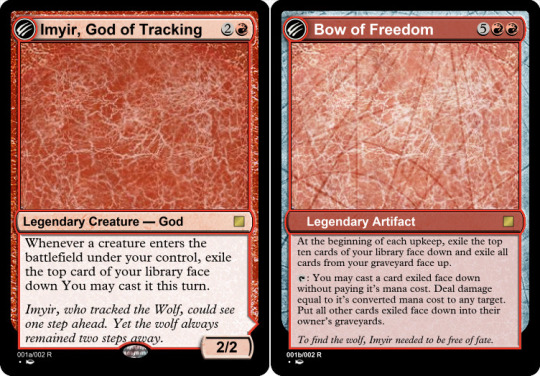

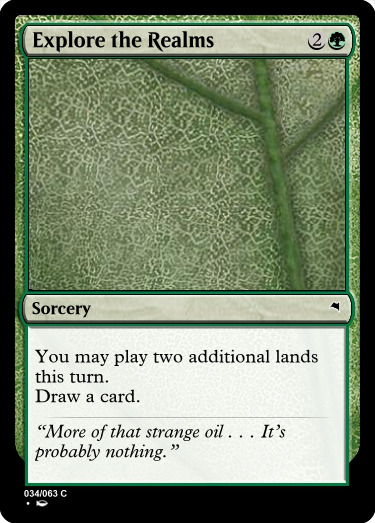
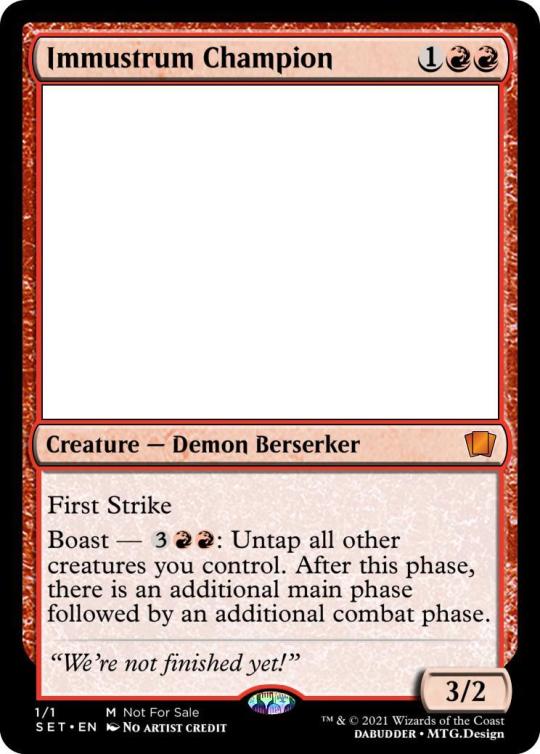
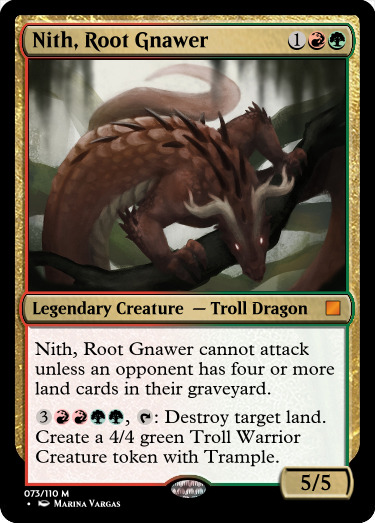

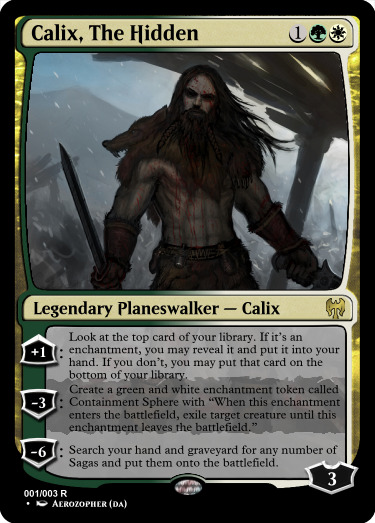
@bread-into-toast - Halvar, God of Battle // Sword of the Realms
Charmera - Imyir, God of Tracking // Bow of Freedom
@col-seaker-of-the-memiest-legion - Scythed Whirlwind
@corporalotherbear - Explore the Realms
@dabudder - Immustrum Champion
@deg99 - Nith, Root Gnawer
@demimonde-semigoddess - Huatli, Guiding Hand
@dimestoretajic - Calix, the Hidden
6 notes
·
View notes
Text
Heim Sweet Heim
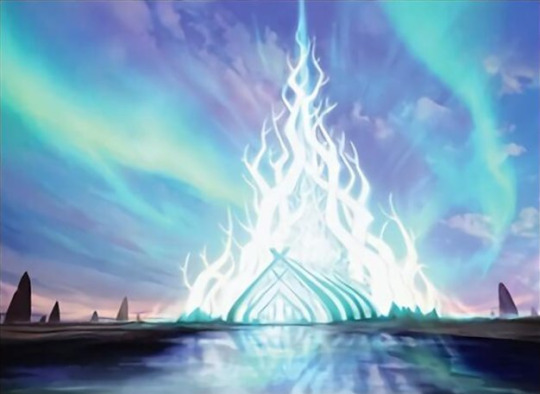
For this week, just a quick rundown of the elements that made Kaldheim, well...Kaldheim. As always, you can peruse Mark Rosewater’s recent articles about the design of the set (found here and here) to get some extra insider information, but we’ll try to cover most of the bases right here.
Mechanics
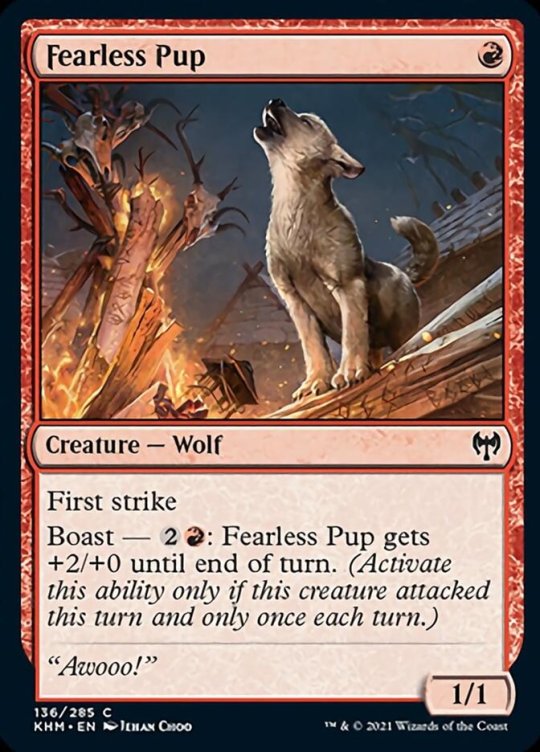
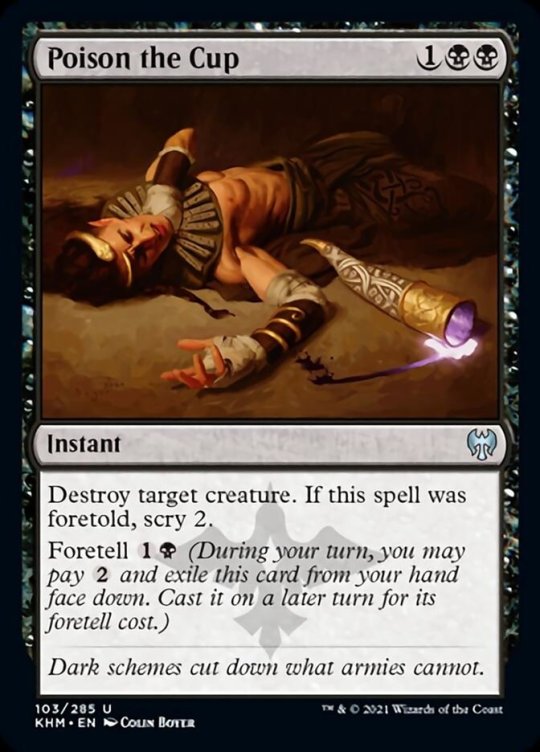

The named mechanics in Kaldheim are Boast, Foretell, and Snow - you can once again include Modal Double-Faced Cards as a mechanical theme, despite the fact that it isn’t named explicitly on cards. Each of these mechanics has its own execution both technically and conceptually, so it’s important to be open to cues the set gives about how the mechanics were used this time around, both in terms of the important ways they innovated and the things they left for future sets. Additionally, take advantage of all the work that’s beendone for you: if you notice that many applications of a mechanic work in the same area, rather than just blindly trying something ‘different’, consider why those ‘different’ designs didn’t make it to print in the first place, and look for clever compromises between the good gameplay of what made the cut and areas you’d like to innovate in.
Archetypes
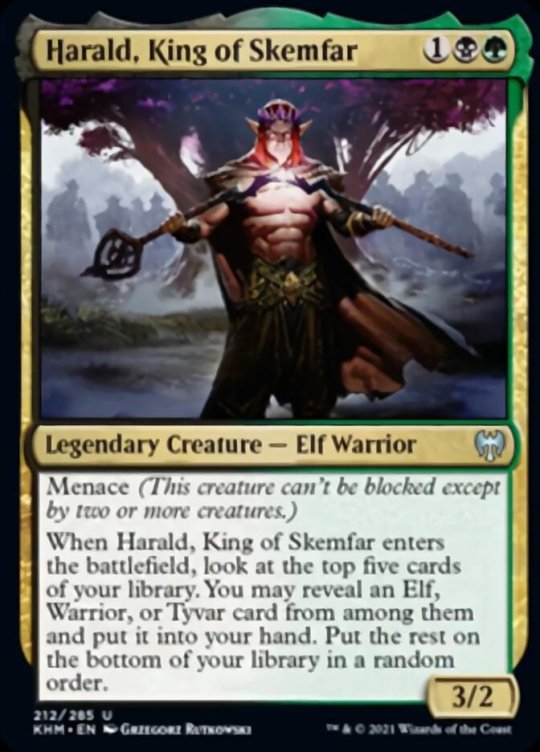
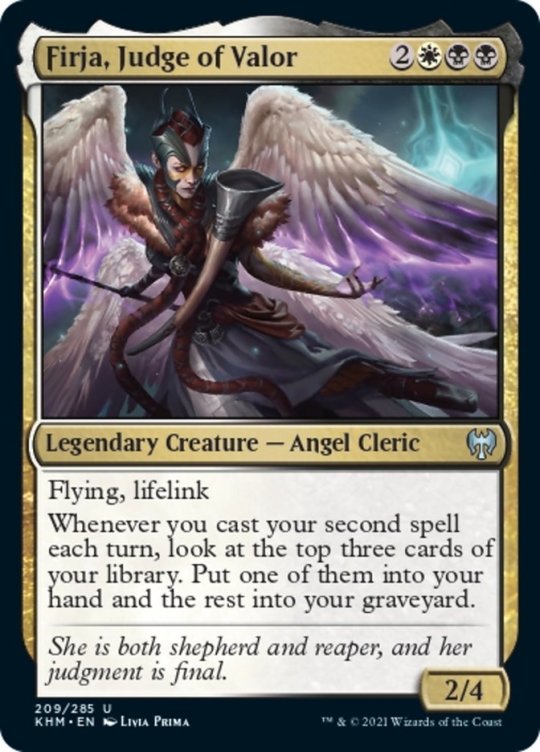
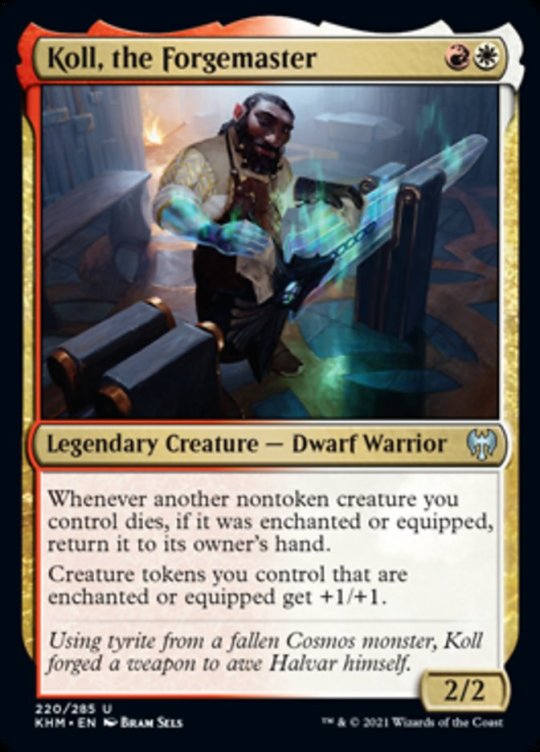
As has become standard in modern set design, there are ten archetype-defining multicolor creatures - in this set, all legendary - that define the 10 main draft archetypes of the set. As always, some of those will align directly with the mechanics in the set (like WU Foretell or UB Snow), but with many more archetypes than there are named mechanics, several won’t. It’s very useful to keep in mind how the major mechanics of the set support and enable these themes, and how these themes overlap and support each other as well. Much of the actual design work in the set goes toward creating cards to fill the spaces between archetypes, those flexible enough to fit several archetypes, as well as valuable payoffs for committing to one archetype in particular. Since these are most relevant in Limited, be particularly conscious of archetypes when designing commons and uncommons.
Top-Down
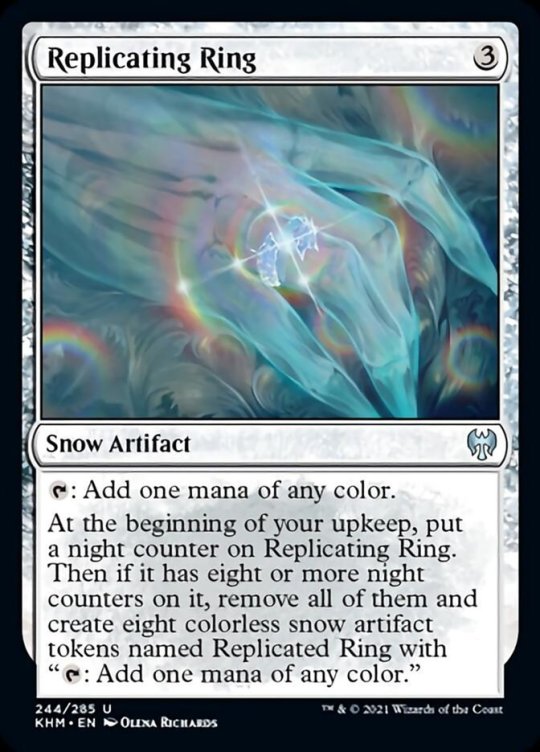
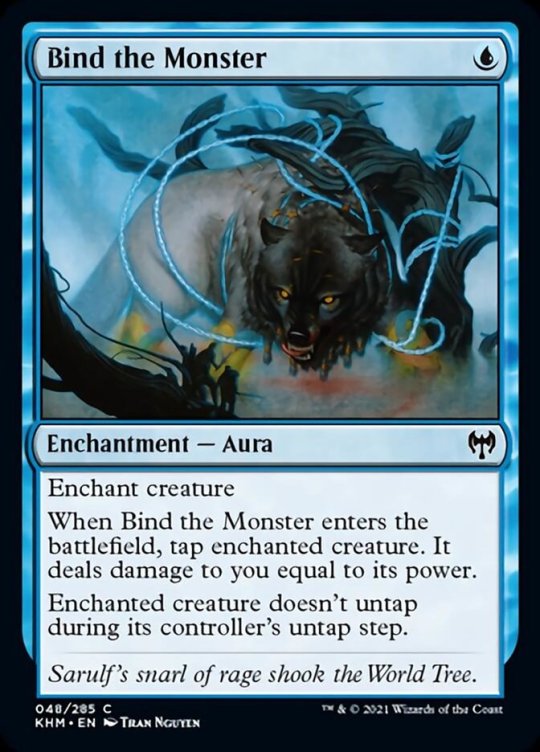

In top-down sets like this one, there is also a subset of cards that aim simply to capture aspects of the source material expressed in Magic terms. Set design generally winds up compromising between the most familiar stories to a wide audience and those easiest to represent on cards, with a few deeper cuts allowed for those more intimately familiar. The best designs in this category are generally those that make sense in isolation but have an added layer of enjoyment for players who know the story behind them, rather than those that actually require outside homework to make sense of in the first place.
--
Keep these things in mind as you work on your new Kaldheim inclusions this week, and try to spend a little extra time looking through the full set to see if you can pick up on themes, cycles, or patterns that weren’t mentioned here. There’s a lot of work that went into the set to unpack, and plenty to learn from exploring its design!
~Mod [ @3smuth ]
5 notes
·
View notes
Text
Kald’ve, Would’ve, Should’ve Entries (3/4)
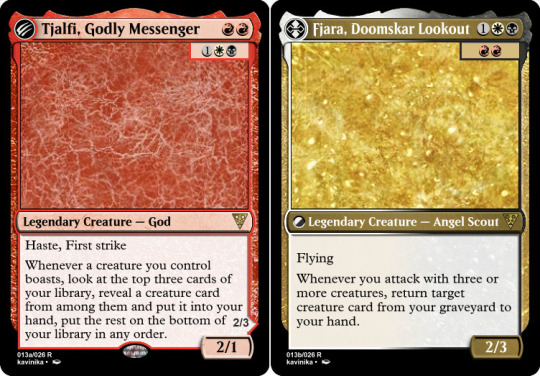
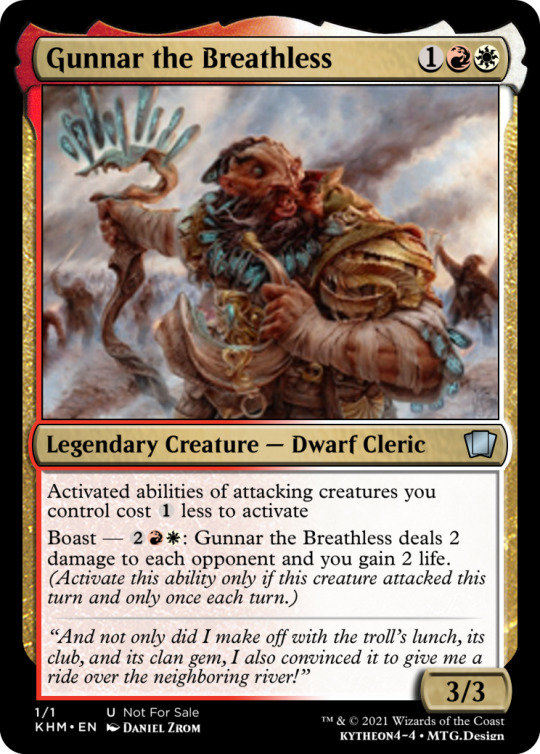
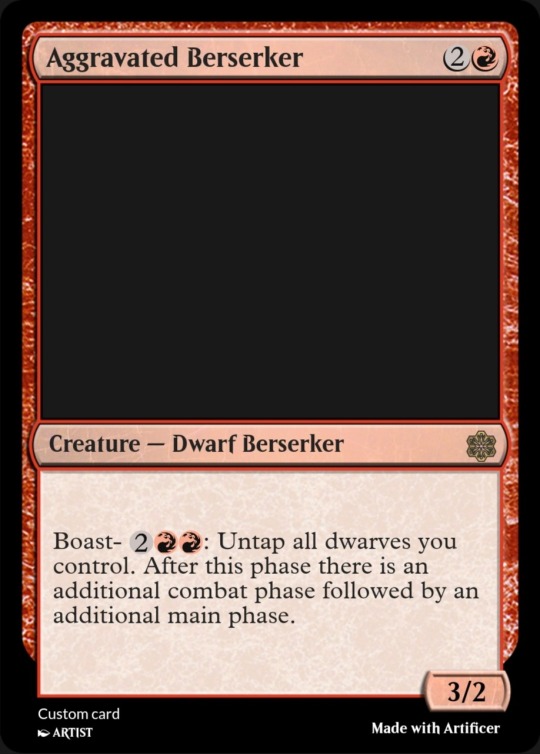
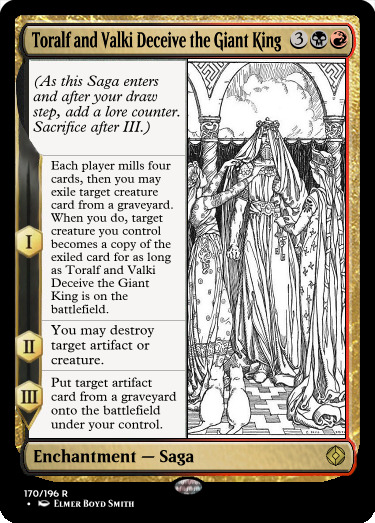
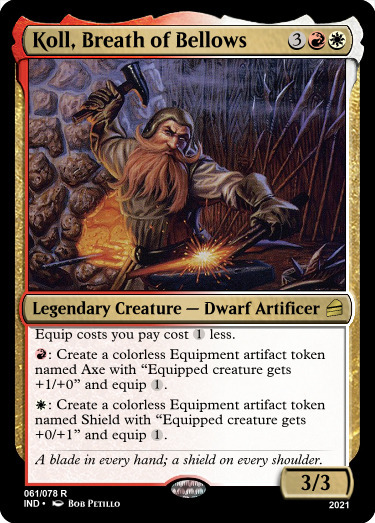
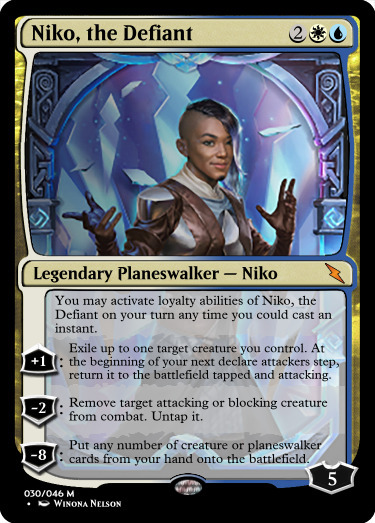


@kavinika - Tjalfi, Godly Messenger // Fjara, Doomskar Lookout
@kytheon4-4 - Gunnar the Breathless
@masternexeon - Aggravataed Berserker
@misterstingyjack - Toralf and Valki Deceive the Giant King
@mtg-ds - Koll, Breath of the Bellows
@naban-dean-of-irritation - Niko, the Defiant
@nine-effing-hells - Fraenir, the Greed-Cursed
@partlycloudy-partlyfuckoff - Pagan Chamberlain
4 notes
·
View notes
Text
Kald’ve, Would’ve, Should’ve Entries (2/4)
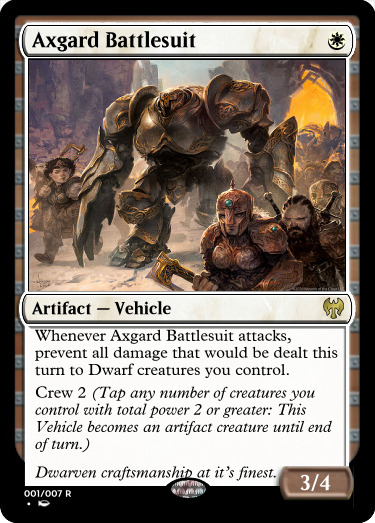


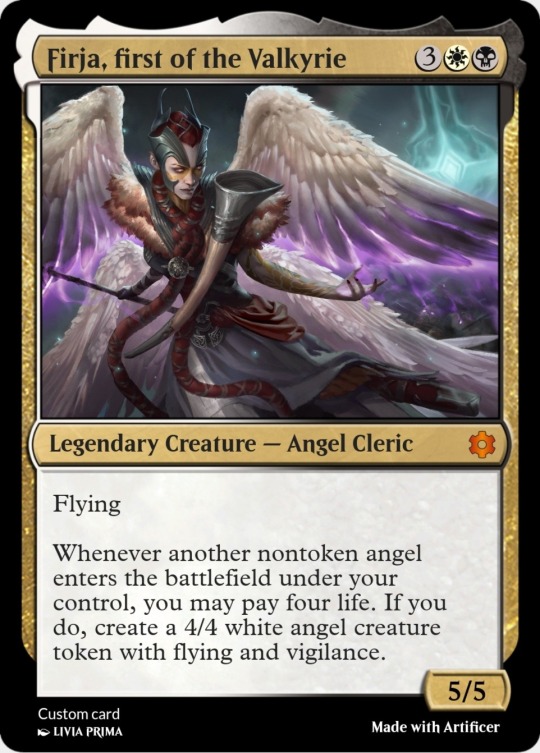

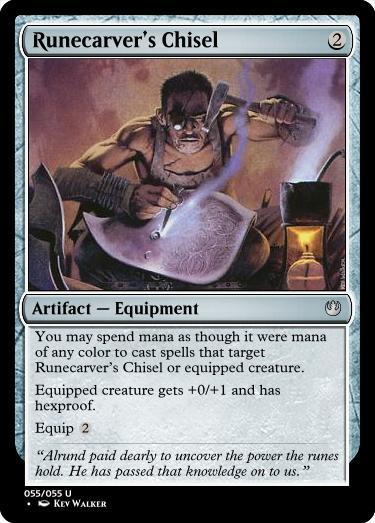

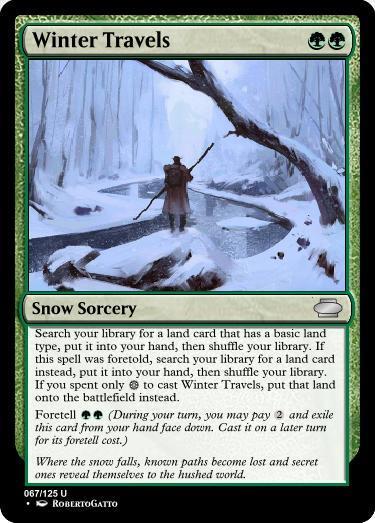
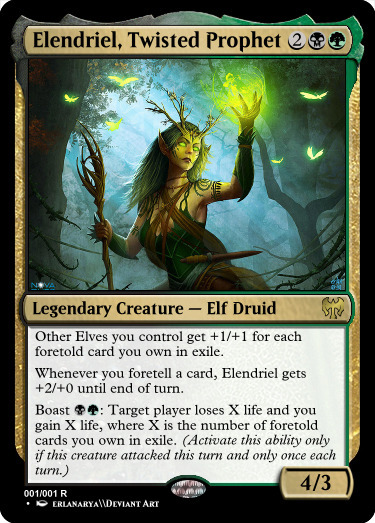
@dumbellsndragons - Axgard Battlesuit
@driftingthruthecosmos - Immortal Triumph
@evscfa1 - Mistlebranche, Cosmic Prank
@fractured-infinity - Firja, First of the Valkyrie
@gollumni - Tuskeri Obituary
@hiygamer - Runecarver's Chisel
@hypexion - Kaya's Gambit
@i-am-the-one-who-wololoes - Winter Travels
@ignorantturtlegaming - Elendriel, Twisted Prophet
4 notes
·
View notes
Text
Kald’ve, Would’ve, Should’ve Entries (4/4)
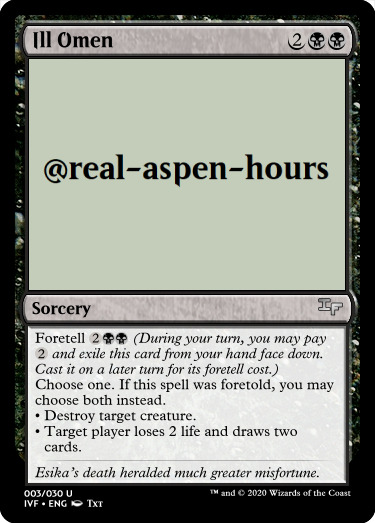

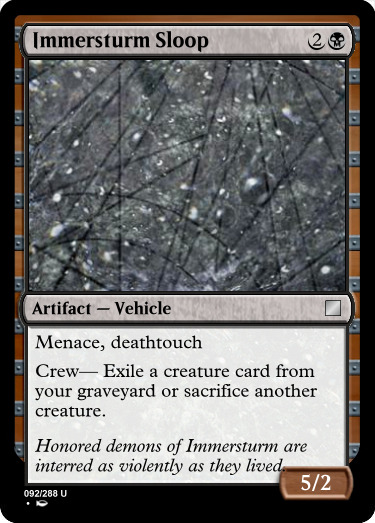
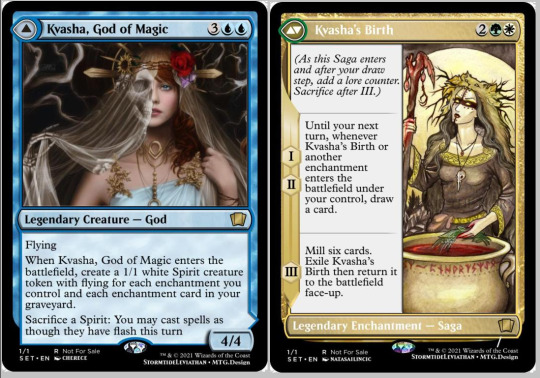

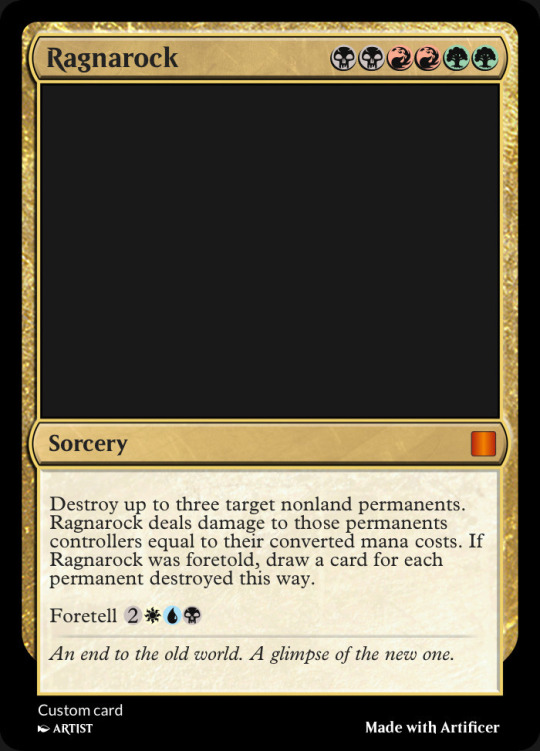
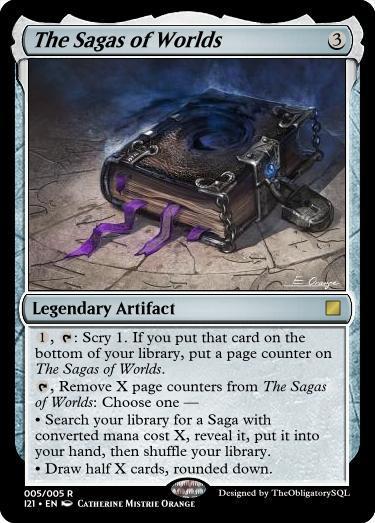
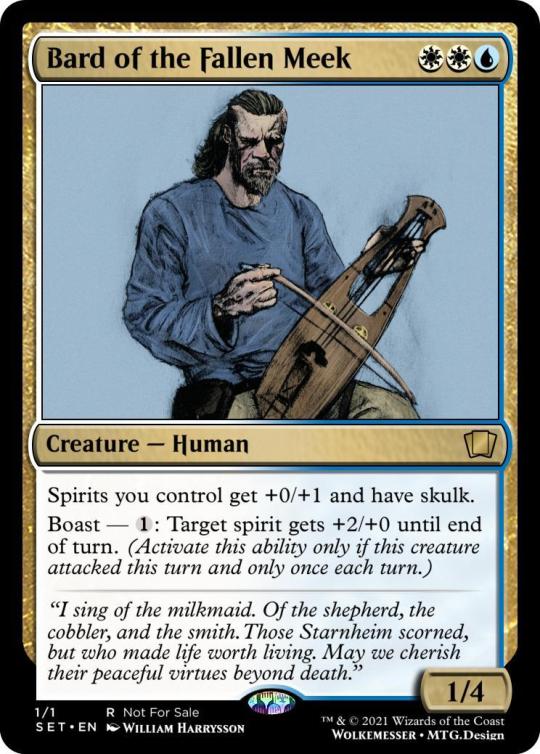
@real-aspen-hours - Ill Omen
@snugz - Surtland Rimereader
@starch255 - Immersturm Sloop
@stormtide-leviathan - Kvasha, God of Magic // Kvasha's Birth
@teaxch - Olunuar, the Many-Legged
@thedirtside - Ragnarock
@theobligatorysql - The Sagas of Worlds
@wolkemesser - Bard of the Fallen Meek
2 notes
·
View notes